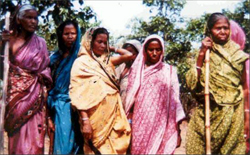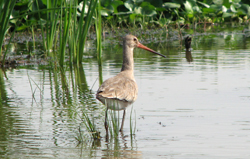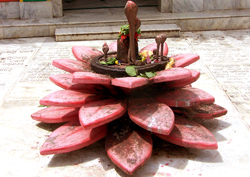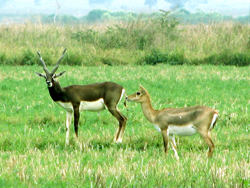 |
Forest
Conservation |
 |
| |
T he
history of community forest protection and
management in the State dates back to pre
independence days. These initiatives were the result
of spontaneous reaction to increasing resource
scarcity caused, among other reasons, by the State’s
commercial exploitation of the forest. These
initiatives existed in the backdrop of the local
people’s struggle to assert control over natural
resources. he
history of community forest protection and
management in the State dates back to pre
independence days. These initiatives were the result
of spontaneous reaction to increasing resource
scarcity caused, among other reasons, by the State’s
commercial exploitation of the forest. These
initiatives existed in the backdrop of the local
people’s struggle to assert control over natural
resources.
There are about 12,000 forest protecting groups,
spread all over Orissa protecting around two million
hectares of forest ranging from a few years old to
several generations old. These initiatives exhibit
an array of diversity in origin, management systems,
institutional arrangements, benefit sharing
mechanism and conflict resolution. This signifies
situation specific conservation models evolved due
to various interacting factors. Livelihood assurance
through collection of forest produces, ecological
services and economic benefits from the forest were
the main considerations behind many initiatives,
thus, it is the interaction between forest and the
local community, where people felt the need to
secure their future through local action. Further
years of protection have resulted in well stocked
forest and
excellent biodiversity. The Forest Survey of India (FSI)
reports of 2001 and 2003 have recognized the
achievement of these initiatives by clearly
mentioning that most of the open forest in the State
have been converted into dense forest due to
community efforts.
Case studies:
|
|
|
 |
Wetland and
Coastal Marine Conservation |
 |
| |
 Orissa’s
coastline of 480 sq kms ranks among the world’s
largest turtle nesting and waterfowl wintering
grounds, along with considerable other wildlife.
Community efforts are visible in various points here
too. The wetlands and coasts of the State are
providing shelter to thousands of migratory birds
and sea turtles. The State also holds distinctive
examples where local communities are conserving
migratory animals/birds even at the expense of their
livelihood. Orissa’s
coastline of 480 sq kms ranks among the world’s
largest turtle nesting and waterfowl wintering
grounds, along with considerable other wildlife.
Community efforts are visible in various points here
too. The wetlands and coasts of the State are
providing shelter to thousands of migratory birds
and sea turtles. The State also holds distinctive
examples where local communities are conserving
migratory animals/birds even at the expense of their
livelihood.
Case studies:
|
|
|
|
|
 |
Culturally
Conserved Areas |
 |
| |
 Orissa
has a long tradition of cultural conservation. The
philosophy of conservation lies in the culture and
ethos of society that encompasses care of forest in
the form of sacred groves or worship wild species as
incarnation of God. Many endangered species
threatened to extinction in other places are
conserved in areas where religious sentiments are
attached with these creatures. In these areas the
protected animal is considered as an incarnation of
God and killing the animal is a taboo. Though there
is a religious belief behind the protection, the
conserving community develops emotional bonds with
animals that ensure sustained efforts to conserve
the species. In most of the cases, security imparted
to particular species is nothing but realization of
its role in life supporting system. Here the roots
of initiative lies deep in traditional ecological
knowledge system implemented though religious
institutions. Some times villagers get fascinated by
attractive animals and believe it as incarnation of
God Orissa
has a long tradition of cultural conservation. The
philosophy of conservation lies in the culture and
ethos of society that encompasses care of forest in
the form of sacred groves or worship wild species as
incarnation of God. Many endangered species
threatened to extinction in other places are
conserved in areas where religious sentiments are
attached with these creatures. In these areas the
protected animal is considered as an incarnation of
God and killing the animal is a taboo. Though there
is a religious belief behind the protection, the
conserving community develops emotional bonds with
animals that ensure sustained efforts to conserve
the species. In most of the cases, security imparted
to particular species is nothing but realization of
its role in life supporting system. Here the roots
of initiative lies deep in traditional ecological
knowledge system implemented though religious
institutions. Some times villagers get fascinated by
attractive animals and believe it as incarnation of
God
Case studies:
|
|
|
 |
Species
Protection |
 |
| |
Many examples can be sited in
Orissa where the communities are actively protecting
individual species of wildlife. Many endangered
species threatened to extinction are conserved in
theses areas and eventually the conserving community
develops emotional bonds with the animals. This has
ensured sustained efforts to conserve the species.
In most of the cases, security imparted to
particular species is nothing but realization of its
role in life supporting system. Here the roots of
initiative lie deep in traditional ecological
knowledge system and many a time villagers get
fascinated by the attractive animals and believe it
as incarnation of God.
 Case studies:: Case studies::
- Kodbahal
spotted deer
- Pakidi
|
|
|
|

|
|